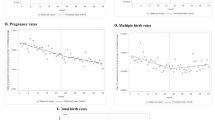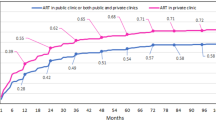Abstract
This paper exploited variation in mandated insurance coverage of assisted reproductive technology (ART) across US states and over time to examine the connection between the price of ART and women’s timing of family including marriage and child bearing in and out of wedlock. Duration and competing risks analyses were estimated to investigate the effects of ART insurance mandates on women’s timing of first marriage and first birth using the 1968–2009 Panel Study of Income Dynamics. The findings suggest that the mandates were associated with delayed marriage and childbearing at younger ages and an increased likelihood of marriage and motherhood at ages 30 and older, but only for college graduate women. For the full sample of women, the mandates were associated with an increased likelihood of marriage at ages 25 and older and motherhood within marriage after at ages 30 and older, but not with delay at younger ages. Results by race were similar to those for the full sample for Whites, but were generally less significant for Blacks. No significant effects of the mandates were found for out-of-wedlock childbearing.

Similar content being viewed by others
Notes
See RESOLVE (2015) for a comprehensive list of coverage and coverage exceptions by state.
Centers for Disease Control and Prevention, National Center for Health Statistics, VitalStats.
While it would be useful to compare the number of clinics for earlier years, 1995 is the earliest year clinic statistics are available. This figure excludes New Jersey and Louisiana since they adopted mandates in 2001 and change mandate status over the period depicted by the figure. Including these states results in a qualitatively similar depiction.
For 1997–2009, the PSID only covers odd-numbered years. I extrapolated residence for even-numbered years.
Since individuals of other races make up a very small proportion of the sample, specifications were run separately for Whites and Blacks only.
This methodology is consistent with the approach used by Bitler and Schmidt (2012).
Standard errors were not estimable for the specification for birth within marriage; however, the magnitudes of the hazard ratio estimates are consistent with those estimated for births within and out of wedlock.
References
Abramowitz, J. (2014). Turning back the ticking clock: The effect of increased affordability of assisted reproductive technology on women’s marriage timing. Journal of Population Economics, 27(2), 603–633. doi:10.1007/s00148-013-0487-3.
Abramowitz, J., & Dillender, M. (2015). Measuring marriage rates over time: Implications for empirical analyses. U.S. Census Bureau: Unpublished manuscript.
Acs, G., Long, S. H., Marquis, M. S., & Short, P. F. (1996). Self-insured employer health plans: Prevalence, profile, provisions, and premiums. Health Affairs, 15(2), 266–278. doi:10.1377/hlthaff.15.2.266.
Akerlof, G. A., Yellen, J. L., & Katz, M. L. (1996). An analysis of out-of-wedlock childbearing in the United States. Quarterly Journal of Economics, 111(2), 277-317. Retrieved from http://www.jstor.org/stable/2946680.
American Society for Reproductive Medicine. (2011). State infertility insurance laws. Retrieved from http://asrm.org/insurance.aspx.
Bailey, M. J. (2006). More power to the pill: The impact of contraceptive freedom on women’s life cycle labor supply. The Quarterly Journal of Economics, 121(1), 289–320. Retrieved from http://www.jstor.org/stable/25098791.
Beauchamp, A. (2016). Abortion costs, separation, and non-marital childbearing. Journal of Family and Economic Issues, Online First. doi:10.1007/s10834-015-9473-0.
Becker, G. S. (1973). A theory of marriage: Part I. The Journal of Political Economy, 81(4), 813-846. Retrieved from http://www.jstor.org/stable/1831130.
Becker, G. S. (1974). A theory of marriage: Part II. The Journal of Political Economy, 82(2), S11–S26. Retrieved from http://www.jstor.org/stable/1829987.
Becker, G. S. (1981). A Treatise on the Family. Cambridge, MA: Harvard University Press.
Bitler, M. (2008). Effects of increased access to infertility treatment on infant and child health: Evidence from health insurance mandates. NBER/IZA/University of California-Irvine: Unpublished Manuscript.
Bitler, M., Gelbach, J., Hoynes, H., & Zavodny, M. (2004). The impact of welfare reform on marriage and divorce. Demography, 41(2), 213–236. doi:10.1353/dem.2004.0011.
Bitler, M., & Schmidt, L. (2006). Health disparities and infertility: Impacts of state-level insurance mandates. Fertility and Sterility, 85(4), 858–865. doi:10.1016/j.fertnstert.2005.11.038.
Bitler, M., & Schmidt, L. (2012). Utilization of infertility treatments: The effects of insurance mandates. Demography, 49(1), 125–149. doi:10.1007/s13524-011-0078-4.
Blau, F. D., Kahn, L. M., & Waldfogel, J. (2000). Understanding young women’s marriage decisions: The role of labor and marriage market conditions. Industrial and Labor Relations Review, 53(4), 624–647. doi:10.1177/001979390005300404.
Buckles, K. S. (2005). Stopping the biological clock: Fertility therapies and the career/family tradeoff. Boston University. Unpublished Manuscript.
Buckles, K. S. (2013). Infertility insurance mandates and multiple births. Health Economics, 22(7), 775–789. doi:10.1002/hec.2850.
Bumpass, L. L., Sweet, J. A., & Cherlin, A. (1991). The role of cohabitation in declining rates of marriage. Journal of Marriage and the Family, 53(4), 913–927. Retrieved from http://www.jstor.org/stable/352997.
Bundorf, M. K., Henne, M., & Baker, L. (2007). Mandated health insurance benefits and the utilization and outcomes of infertility treatments. (Working Paper No. 12820), National Bureau of Economic Research, Inc. Retrieved from http://www.nber.org/papers/w12820.pdf.
Centers for Disease Control and Prevention, American Society for Reproductive Medicine, & Society for Assisted Reproductive Technology. (2012). 2010 assisted reproductive technology national summary report. Atlanta, GA: U.S. Department of Health and Human Services. Retrieved from http://www.cdc.gov/art/ART2010/PDFs/ART_2010_National_Summary_Report.pdf.
Centers for Disease Control and Prevention, National Center for Health Statistics. (2014). Key statistics from the National Survey of Family Growth. Retrieved from http://www.cdc.gov/nchs/nsfg/key_statistics/i.htm.
Chandra, A., & Stephen, E. H. (2010). Infertility service use among US women: 1995 and 2002. Fertility and Sterility, 93(3), 725–736. doi:10.1016/j.fertnstert.2008.10.049.
Cox, D. R. (1972). Regression models and life-tables. Journal of the Royal Statistical Society, Series B (Methodological), 34(2), 187–220. Retrieved from http://www.jstor.org/stable/2985181.
Elliott, D. B., Krivickas, K., Brault, M. W., & Kreider, R. M. (2012). Historical marriage trends from 1890-2010: A focus on race differences. SEHSD Working Paper Number 2012-12. Retrieved from http://www.census.gov/hhes/socdemo/marriage/data/acs/ElliottetalPAA2012paper.pdf.
Fine, J. P., & Gray, R. J. (1999). A proportional hazards model for the subdistribution of a competing risk. Journal of the American Statistical Association, 94(446), 496–509. doi:10.1080/01621459.1999.10474144.
Goldin, C. (2006). The quiet revolution that transformed women’s employment, education, and family. American Economic Review, 96(2), 1–21. doi:10.1257/000282806777212350.
Goldin, C., & Katz, L. F. (2002). The power of the pill: Oral contraceptives and women’s career and marriage decisions. Journal of Political Economy, 110(4), 730–770. doi:10.1086/340778.
Goode, William J. (1982). The Family. Englewood Cliffs, NJ: Prentice Hall.
Gould, E. D., & Paserman, M. D. (2003). Waiting for Mr. Right: Rising inequality and declining marriage rates. Journal of Urban Economics, 53(2), 257–281. doi:10.1016/S0094-1190(02)00518-1.
Hamilton, B. H., & McManus, B. (2012). The effects of insurance mandates on choices and outcomes in infertility treatment markets. Health Economics, 21(8), 994–1016. doi:10.1002/hec.1776.
Hewlett, S. A. (2002). Creating a Life: Professional Women and the Quest for Children. New York: Talk Miramax Books.
Jensen, G. A., & Morrisey, M. A. (1999). Employer-sponsored health insurance and mandated benefit laws. Milbank Quarterly, 77(4), 425–459. doi:10.1111/1468-0009.00147.
King, L., & Meyer, M. H. (1997). The politics of reproductive benefits: U.S. insurance coverage of contraceptive and infertility treatments. Gender and Society, 11(1), 8–30. doi:10.1177/089124397011001002.
Klerman, J., & Haider, S. (2004). A stock-flow analysis of the welfare caseload. Journal of Human Resources, 29(4), 865–886. doi:10.3368/jhr.XXXIX.4.865.
Lahey, J. N. (2012). The efficiency of a group-specific mandated benefit revisited: The effect of infertility mandates. Journal of Policy Analysis and Management, 31(1), 63–92. doi:10.1002/pam.20616.
Leridon, H. (2004). Can assisted reproduction technology compensate for the natural decline in fertility with age? A model assessment. Human Reproduction, 19(7), 1548–1553. doi:10.1093/humrep/deh304.
Lichter, D., McLaughlin, D., & Ribar, D. (2002). Economic restructuring and the retreat from marriage. Social Science Research, 31(2), 230–256. doi:10.1006/ssre.2001.0728.
Loughran, D. S. (2002). The effect of male wage inequality on female age at first marriage. The Review of Economics and Statistics, 84(2), 237–250. doi:10.1162/003465302317411505.
Machado, M. P., & Sanz-de-Galdeano, A. (2015). Coverage of infertility treatment and fertility outcomes. SERIEs, 1–33. doi: 10.1007/s13209-015-0135-0.
Modell, J. (1985). Historical reflections on American marriage. In K. Davis & S. Grossbard-Shechtman (Eds.), Contemporary Marriage: Comparative Perspectives on a Changing Institution. New York, NY: Russell Sage Foundation.
Myers, C. K. (2012). Power of the pill or power of abortion?. IZA Discussion Paper No: Re-examining the effects of young women’s access to reproductive control. 6661.
Ohinata, A. (2011). Did the US infertility health insurance mandates affect the timing of first birth? (Working Paper No. 2011-102), CentER Working Paper Series. doi:10.2139/ssrn.1924169.
RESOLVE. (2015). Insurance coverage in your state. Retrieved from http://www.resolve.org/family-building-options/insurance_coverage/state-coverage.html.
Schaller, J. (2013). For richer, if not for poorer? Marriage and divorce over the business cycle. Journal of Population Economics, 26(3), 1007–1033. doi:10.1007/s00148-012-0413-0.
Schmidt, L. (2007). Effects of infertility insurance mandates on fertility. Journal of Health Economics, 26(3), 431–446. doi:10.1016/j.jhealeco.2006.10.012.
Shreffler, K. M., & Johnson, D. R. (2013). Fertility intentions, career considerations and subsequent births: The moderating effects of women’s work hours. Journal of Family and Economic Issues, 34, 285–295. doi:10.1007/s10834-012-9331-2.
Survey Research Center, Institute for Social Research, University of Michigan. (2012). Panel study of income dynamics [Data file]. Retrieved from http://simba.isr.umich.edu/default.aspx.
Thornton, A. (1989). Changing attitudes toward family issues in the United States. Journal of Marriage and the Family, 51, 873–893. doi:10.2307/353202.
Acknowledgments
The author is grateful to Shelly Lundberg, Anirban Basu, Seik Kim, Judith Thornton, Robert Plotnick, Elaina Rose, Rachel Heath, Laura Hosken, and Rob Letzler for their invaluable feedback. I would also like to thank seminar participants at the 2011 Western Economics Association International annual meetings and 2012 Society of Labor Economists annual meetings for their helpful comments.
Author information
Authors and Affiliations
Corresponding author
Rights and permissions
About this article
Cite this article
Abramowitz, J. Assisted Reproductive Technology and Women’s Timing of Marriage and Childbearing. J Fam Econ Iss 38, 100–117 (2017). https://doi.org/10.1007/s10834-016-9485-4
Published:
Issue Date:
DOI: https://doi.org/10.1007/s10834-016-9485-4




